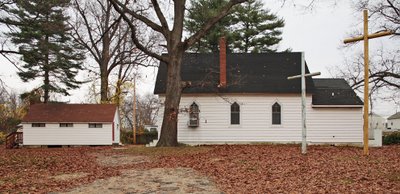 |
| Hyde Station, Hydes Maryland |
The Maryland & Pennsylvania Railroad (MA&PA) passed through Hyde & Baldwin, Maryland, which are about a mile apart, and there is a station in each place. The reason for this is while Baldwin, a prosperous little crossroads, was the obvious choice for a station, Hyde (later called Hydes and as lonely then as it is now), featured a cannery. And also because the MA&PA was always hard up for revenue on the Maryland portion of the tracks; they'd stop for a barking dog, if there was the possibility of it buying a ticket.
The cannery sat across the street from the station and a portion of it sat there well into the 1980's until, for no apparent reason, it was torn down. I always liked that little ruin. The cannery itself was instrumental in getting the MA&PA, or one of its predecessors, up and running, as it was used to demonstrate to prospective investors that the line was financially viable. (Which it wasn't really; not at the time.) I read that the railroad took all those investors on an excursion one day, to eat corn. And that has always stuck with me, and it's why I am such an awful railfan. I didn't care much about the coaches they rode in, or the engine that pulled them, the thing that stuck in my mind was this: Why would those people give up a day to ride a train and eat corn? Were they just playing along, or did they really want to do such a thing?
I like to think that they enjoyed themselves. And not because the 19th century was that dull; it wasn't, not for prosperous Baltimoreans. I imagine it was for the same reasons that my own parents were, in my eyes, so very boring. They weren't dull for lack of wit, or lack of funds, or lack of imagination; they were dull because of history. Rather they were dull for having experienced what is often considered exciting history: The Great Depression and World War Two. After that they didn't want any more excitement. They and their friends were happy to cultivate their gardens; which they did in droves, in the great and new suburbs of America. And that's how I picture those men on that train, Civil War vets, probably most of them, and most of them having more than one sibling or spouse dead at an early age from cholera, or yellow fever, or diphtheria, or whooping cough, and most of them having survived all the "panics" that wiped out fortunes, large & small, every ten years or so back then, sitting on a plush seat contentedly eating a plate of corn and thinking, "this sure beats getting your ass shot off at Little Round Top."
 |
| Baldwin Station, Baldwin, Maryland |
Canon EOS 30D & EF-S 17-55 f/2.8 IS lens











































